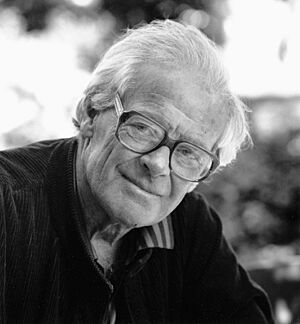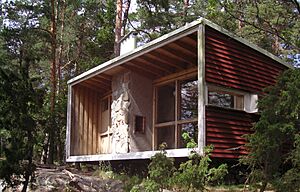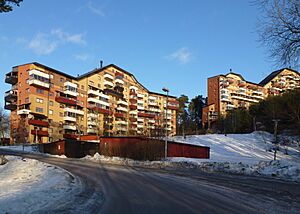Ralph Erskine (architect) facts for kids
Quick facts for kids
Ralph Erskine
|
|
|---|---|

Erskine in 1987
|
|
| Born | 24 February 1914 |
| Died | 16 March 2005 (aged 91) |
Ralph Erskine was a famous British architect and city planner. He was born in England but spent most of his life living and working in Sweden. He lived from February 24, 1914, to March 16, 2005. He is known for designing buildings that fit well with their surroundings and help the people who live in them.
Contents
Early Life and Ideas
Ralph Erskine was born in London, England, in 1914. He grew up in a place called Mill Hill. His parents were socialists, which means they believed in a society where everyone is equal and works together. They were part of a group called the Fabian Society.
Even though his family had a background in a different church, his parents sent him to a Quaker school. At this school, he learned about Quaker ideas, which are about peace, equality, and helping others. These ideas greatly shaped how he thought about society and how buildings should be designed to help people.
Learning to Be an Architect
In the 1930s, Ralph Erskine studied architecture for five years at the Regent Street Polytechnic in London. His teacher, Thornton White, made sure students learned about old, classic building styles first.
One of his classmates was Gordon Cullen, who became famous for his ideas about how cities should look and feel. Cullen believed that buildings and their surroundings should work together beautifully. This idea was very important to Erskine. He always made sure his buildings fit perfectly with the land and nature around them.
Career and Move to Sweden
After finishing his studies, Erskine started working on the design team for Welwyn Garden City, a planned town in England. He also studied town planning, which helped him think about how buildings connect to each other and to the people living in them. In 1936, he became a professional architect.
Before World War II started, Erskine traveled to Sweden. He admired the work of Swedish architects like Gunnar Asplund and Sven Markelius, who designed buildings that were useful and modern. He also liked that Sweden was building a strong social welfare system, which meant the government helped its citizens with things like housing and healthcare. These ideas matched his own beliefs about helping people through architecture. He decided to stay in Sweden and made a big impact on buildings there and in England.
Key Projects and Designs
Ralph Erskine designed many unique buildings in Sweden, England, and Canada. His designs showed his strong beliefs about how architecture should serve people and fit into its environment. Some of his important projects include:
- Gyttorp, Sweden (1945-1955): A housing project for a factory town.
- Ski Hotel at Borgafjall (1948–50): A hotel designed for a snowy, mountainous area.
- Shopping, Luleå, Sweden (opened 1955): This was the world's first indoor shopping center built for that purpose.
- Brittgården Residential Area, Tibro, Sweden (1956–59): A neighborhood designed for comfortable living.
- Svappavaara, Kiruna Municipality, Sweden (1962): Housing for a copper mine community located far north, above the Arctic Circle.
- Clare Hall, Cambridge, England (1969): A college building at the University of Cambridge.
- Eaglestone, Milton Keynes, England (1972–76): A residential area designed as part of a new city.
- The Byker Redevelopment, Newcastle upon Tyne, England (1969–82): A famous housing project known for its long, curved building called the Byker Wall.
- Stockholm University Library, Sweden (opened 1983): And other buildings on the university campus, like the main auditorium, Aula Magna.
- The London Ark, Hammersmith, London (1990): A unique office building shaped like a ship.
- Greenwich Millennium Village, London (2000–05): A modern community designed to be sustainable and people-friendly.
Erskine's work on the Byker Wall in Newcastle and The London Ark made him well-known in Britain. Later in his career, his design for the Greenwich Millennium Village brought even more attention to his important work.
Lasting Impact
Ralph Erskine passed away in 2005. People remembered him as one of the greatest architects of the 20th century. A city leader in Newcastle said that Erskine's Byker estate was one of Europe's best new housing communities after World War II. He focused on helping people and communities, not just building houses. He made sure local people were involved in designing the Byker Wall, so the community could stay together.
Ralph Erskine started his own company in Sweden in 1939. Before he died, he asked that his name be removed from the company. Today, it is called Tovatt Architects and Planners, continuing his legacy.
In 1984, Ralph Erskine and his wife, Ruth, started the Ruth and Ralph Erskine Nordic Foundation. This foundation gives a prize every two years to people or groups who design buildings or communities that are innovative, good for the environment, beautiful, and help those who are less fortunate.
Erskine also wrote the introduction for a famous book called Life Between Buildings by Jan Gehl, which is about how people use and enjoy public spaces. In 1987, he received the RIBA Royal Gold Medal, a very high honor in architecture.
Personal Life
Ralph Erskine met his wife, Ruth, at the Quaker school he attended. They got married in Stockholm in 1939 and had four children. Ruth passed away in 1988. Ralph Erskine is remembered by his children: Jane, Karin, Patrick, and Suzanne.
Images for kids
See also
 In Spanish: Ralph Erskine para niños
In Spanish: Ralph Erskine para niños









